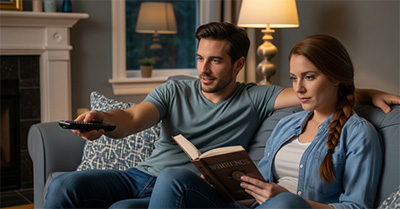Using “And” and “So” | (A-Level, Basic) Page 2
“And” — Adding or Putting Things Together
The coordinating conjunction “and” is like the plus sign (+) in mathematics: 1 + 2 = 3. When you use “and” to connect two sentences or ideas, you simply add the ideas together — or put them together. For example, examine the following ideas:
George is watching TV.
Janet is reading a book.
You can put both ideas together into one sentence using “and.”
George is watching TV, and Janet is reading a book.

George is watching TV and Janet is reading a book.
Examples using “and”
George is a teacher, and Janet is a dentist.
George like watching movies, and Janet likes reading books.
The cat is sleeping, and the dog is playing.
My brother lives in California, and my sister lives in Florida.
“So” — Showing a Logical Conclusion or Effect
When you use “so” to connect ideas, one idea is the cause, and the other is the effect. The other idea is also a conclusion that makes sense based on the first idea.
For example, examine the following ideas:
It’s very late.
I’m going to bed.
”Going to bed” is a logical conclusion from “being very late,” so you can combine these ideas using “so.”
It’s very late, so I’m going to bed.
Examples using “so”
It’s hot, so I’m going to open the window.
John can’t cook, so he eats out every night.
It’s raining, so we are not going to the park anymore.
Jack is going to live in France, so he is learning French.
Up Next: “Or” and “Or Else”
Continue the lesson to learn about the coordinating conjunctions “or” and “or else” to show choices, possibilities, and consequences.